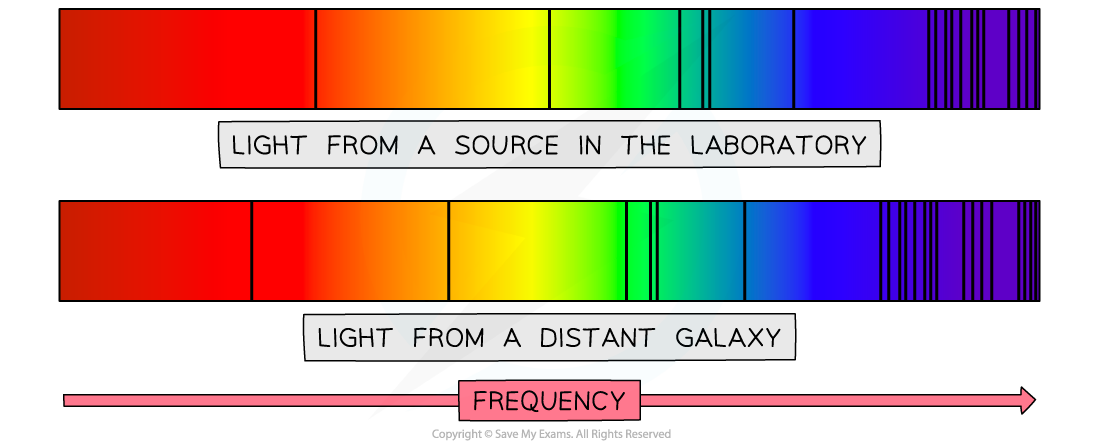- 翰林提供学术活动、国际课程、科研项目一站式留学背景提升服务!
- 400 888 0080
CIE A Level Physics复习笔记25.2.2 Doppler Redshift
Redshift of EM Radiation
- Recall the Doppler effect is defined as:
The apparent change in wavelength or frequency of the radiation from a source due to its relative motion away from or toward the observer
- On Earth, the Doppler effect of sound can be easily observed when sound waves moves past an observer at a notable speed
- In space, the Doppler effect of light can observed when spectra of distant stars and galaxies are observed, this is known as:
- Redshift if the object is moving away from the Earth, or
- Blueshift if the object is moving towards the Earth
- Redshift is defined as:
The fractional increase in wavelength (or decrease in frequency) due to the source and observer receding from each other
- For non-relativistic galaxies, Doppler redshift can be calculated using:

- Where:
- Δλ = shift in wavelength (m)
- λ = wavelength emitted from the source (m)
- Δf = shift in frequency (Hz)
- f = frequency emitted from the source (Hz)
- v = speed of recession (m s-1)
- c = speed of light in a vacuum (m s-1)
Worked Example
The spectra below show dark absorption lines against a continuous visible spectrum.
A particle line in the spectrum of light from a source in the laboratory has a frequency of 4.570 × 1014 Hz. The same line in the spectrum of light from a distant galaxy has a frequency of 4.547 × 1014 Hz. What speed is the distance galaxy moving in relation to the Earth? Is it moving towards or away from the Earth?
Step 1: Write down the known quantities
Emitted frequency, f = 4.570 × 1014 Hz
Shift in frequency, Δf = (4.547 – 4.570) × 1014 = –2.3 × 1012 Hz
Speed of light, c = 3.0 × 108 m s–1
Step 2: Write down the Doppler redshift equation

Step 3: Rearrange for speed v, and calculate

Step 4: Write a concluding sentence
The observed frequency is less than the emitted frequency (the light from a laboratory source), therefore, the source is receding, or moving away, from the Earth at 1.5 × 106 m s–1
Exam Tip
In your exam, be sure to emphasise that redshift means the wavelength of spectral lines increases towards the red end of the spectrum, do not say that the spectral lines become red, as this is incorrect.
An Expanding Universe
- After the discovery of Doppler redshift, astronomers began to realise that almost all the galaxies in the universe are receding
- This lead to the idea that the space between the Earth and the galaxies must be expanding
- This expansion stretches out the light waves as they travel through space, shifting them towards the red end of the spectrum
- The more red-shifted the light from a galaxy is, the faster the galaxy is moving away from Earth

A balloon inflating is similar to the stretching of the space between galaxies
- The expansion of the universe can be compared to dots on an inflating balloon
- As the balloon is inflated, the dots all move away from each other
- In the same way as the rubber stretches when the balloon is inflated, space itself is stretching out between galaxies
- Just like the dots, the galaxies move away from each other, however, they themselves do not move
转载自savemyexams

最新发布
© 2025. All Rights Reserved. 沪ICP备2023009024号-1









